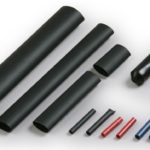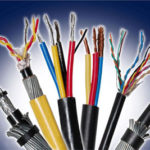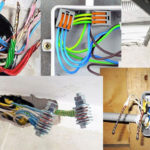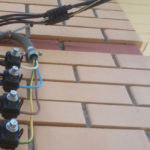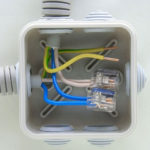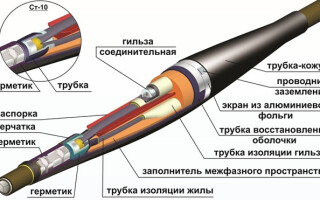In the process of creating various power networks it is often necessary to splice multiple parts of the cable and connect to electrical appliances and devices. Such work is performed with the help of cable fasteners, which are a set of materials and parts necessary for reliable sealing of places of connection or branching of electric conductors. Set completeness varies and depends on the parameters of the electric current, insulation coating and cable design.
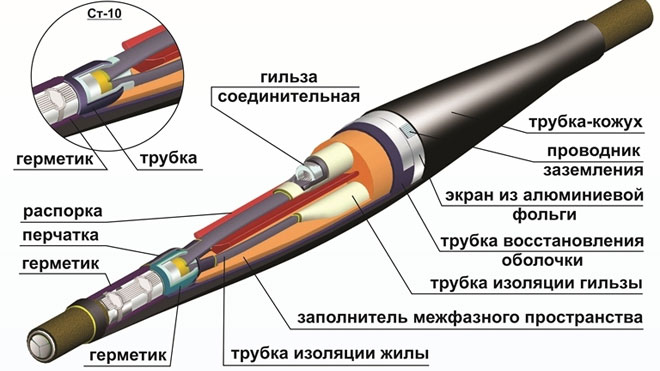
Contents
How to use a cable joint
To connect individual sections of power cable, cable joints are used. The design and the materials used allow for reliability and durability of the connection. Depending on their purpose, they can be:
- repair;
- transitional;
- branching.
Couplings for cable is the most in demand, as it is most often used in the installation of electrical lines. The main requirement imposed on the fasteners of this type is to create a reliable and airtight connection. Due to the fact that the cable coupling is operated in adverse conditions, the material of manufacture must meet the increased requirements for resistance to the influence of the external environment. Depending on the operating conditions, cable couplings are made one-piece and demountable.
Couplings are used to splice electrical lines of different voltage classes. They provide a reliable connection, seal and protect from damage the place of connection of single and multi-core power cables. When installing power lines on vertical and inclined routes, locking and locking-transition cable fasteners are used. It serves not only to connect the conductors, but also prevents the flow of oil-impregnating compound.
Knowing what a cable junction coupler is, it will not be difficult to choose the right model for laying a line in the air or in the ground. A large proportion are products made by cold shrinkage technology.
The work of joining conductors with paper insulation has been simplified by the advent of heat shrinkable tubes and gloves. In most cases, these items are included with electrical products. Heat shrink tubing creates a stronger insulation layer, prevents the paper winding from unraveling and makes the switching process more comfortable.
Conductors are joined by bolted connectors that are placed in the heat shrink tubing. This method is convenient when installing connection-transition sleeves, where conductors with different types of insulation are spliced. The tubes not only equalize the thickness of the insulation layer, but also provide shielding of the junction area.
Types of jointing cable couplings
Cable fittings used for the construction of power lines are defined by the following characteristics:
- type of connection;
- manufacturing material;
- parameters of transmitted power;
- mounting location;
- dimensions;
- number of conductors and shape.
In addition, depending on the material used, the following types of cable couplings are distinguished:
- epoxy;
- lead;
- heat-shrinkable;
- cast-iron;
- brass;
- rubber.
Epoxy fasteners are designed to connect cables laid in mines, tunnels and trenches. The product has an external metal or asbestos body. After connection of cores it is poured with epoxy compound.
Leaded cable fittings are used to join cables with metal or aluminum braid. Available in 2 sizes: normal and small-sized. It is made of lead pipes with diameter 60-110 mm, length 450-650 mm and depends on cable cross section. Such fittings have a large mass. Lead and epoxy couplings are practically unaffected by external influences and can be used when laying underground.
The most common and simplest method of installing cable couplings is the heat shrink design. After the coupling is installed on the section to be connected, it is heated with a construction hairdryer or a burner until the casing effect appears. The tube material is characterized by high insulating properties, and a wide interval of material shrinkage makes it possible to connect cables with different cross sections of conductors.
Rubber couplings are used to connect flexible unshielded conductors. In this case, the connection point remains flexible. No heating is required to install the product. Tightness of the joint is ensured by pouring a special compound.
Recommendations for selection and installation
Mounting of end sleeves is carried out when electrical appliances and devices are connected. For electrical networks with voltages higher than 1 kV, a distinction is made between indoor and outdoor installation. At lower voltages, the coupling device allows installation both indoors and outdoors.
To get a reliable connection of cables, it is necessary to choose the right fastener for the job. To do this, you need to know the following characteristics:
- The voltage of the cable line on which the electrical fixture will be mounted.
- The type of insulation coating of conductors, which can be made of different materials (plastic or oiled paper). This determines the configuration of the device.
- Number of conductors and their cross-section. Determined by cable brand or taken from design documentation.
- Availability of armor tape. Installation of cable fasteners requires armor grounding.
- Type of installation of end terminations. When selecting an end termination, you need to know where to install the latter (inside or outside the building). Fittings differ in the presence (absence) and the number of anti-tracking heat shrinkable insulators.
- Equipment of the product. Delivery can be made with or without bolt connectors and lugs.
Reliable connection of cables is provided with the use of heat shrinkable connecting devices. They not only create additional insulation in the place of installation, but also allow to join conductors with different cross-sections.
In order to install electrical fittings, all layers of insulation material up to the core coating are removed one by one. Installation of heat shrinkable sleeves does not require soldering the conductors. The contact is ensured through the use of bolted connectors.
When connecting an electrical installation to a running line, it is necessary to create a branch wire. For this purpose, tap clamps and terminal blocks are used. The use of piercing clamps ensures a tight joint and does not require stripping the insulation from the main wire. The clamping force is adjusted by the breakaway heads of the clamping bolts.
The grounding conductor of end sleeves is installed using the unsoldered protection system included in the package. In order to protect the contact point from corrosion, the connection between the conductor and the steel sheath is sealed with sealing tape.
Installation of cold shrinkage couplings does not require heating, which positively affects the time of work. These devices are able to maintain the flexibility of the cable. They can withstand temperature cyclic loads and ground displacement in different weather conditions.
Related articles:
